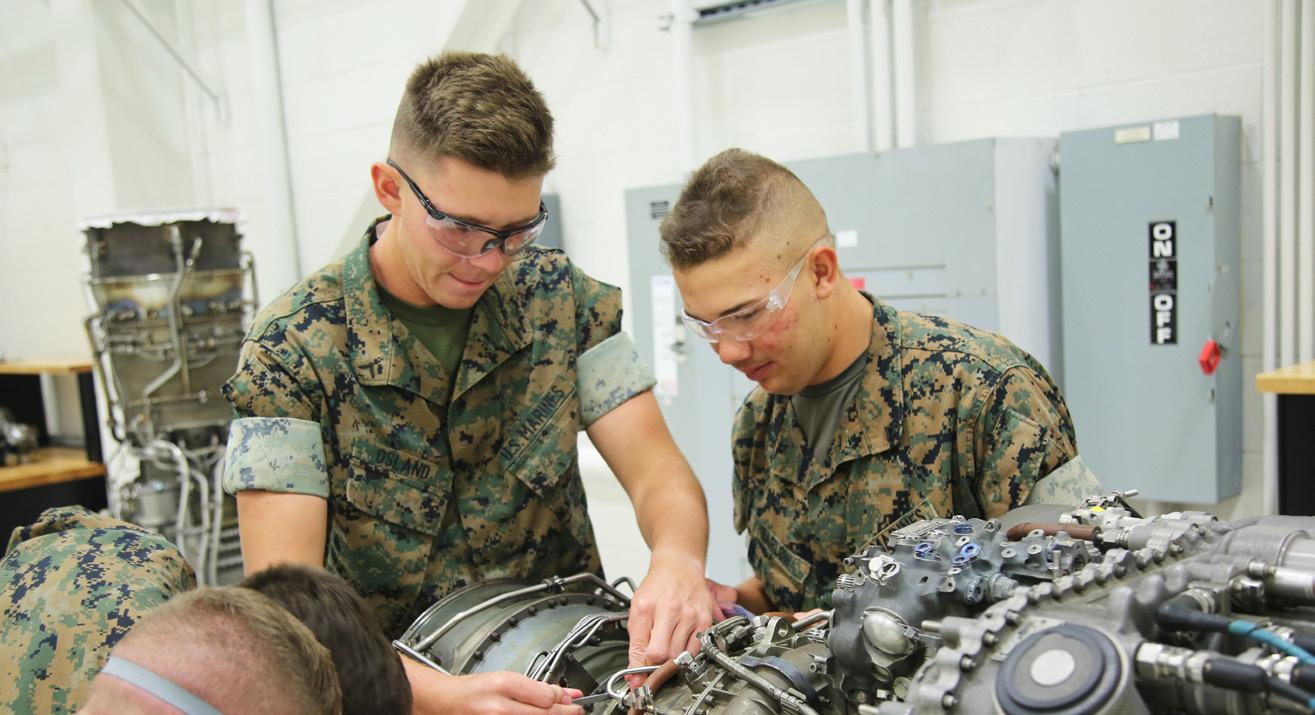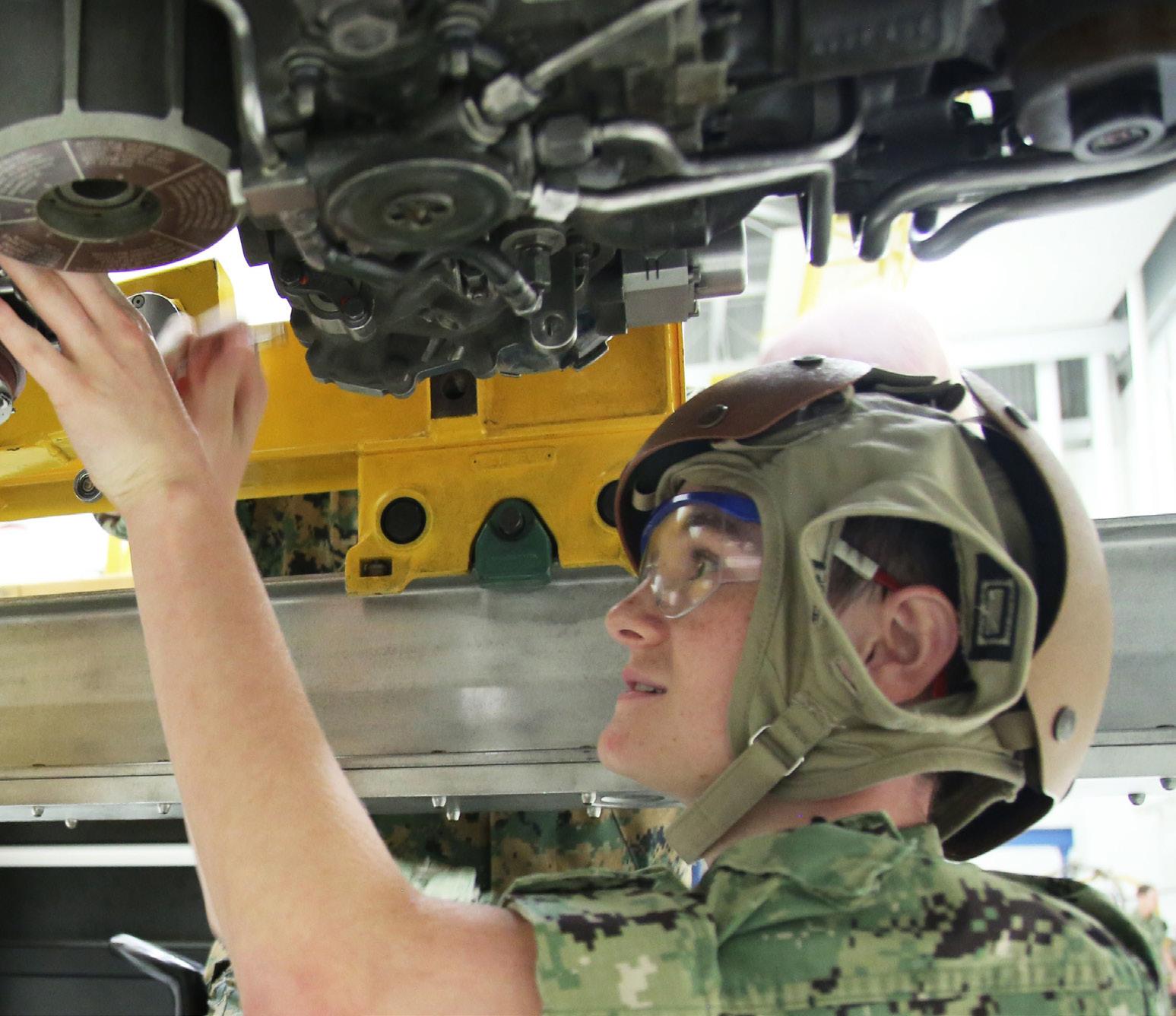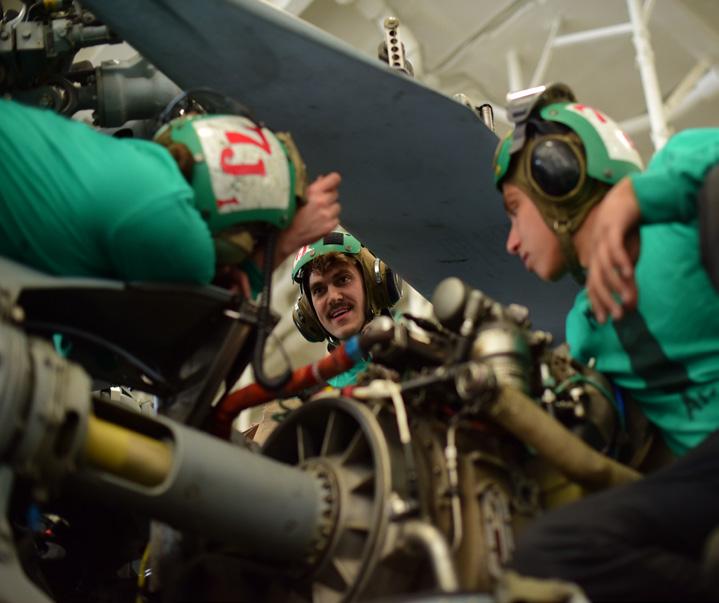
9 minute read
Are you Prepared?
By AE2 Rickey O. Frazier
Advertisement
U.S. Navy photo by Ensign Cody A. Milam.

“Aviation in itself is not inherently dangerous. But to an even greater degree than the sea, it is terribly unforgiving of any carelessness, incapacity or neglect. ” — Captain A. G. Lamplugh, British Aviation Insurance Group In Naval aviation we train to handle emergencies on a regular basis. This training can vary from academic discussions to hands-on drills, all designed to demonstrate understanding of procedures and safety precautions. Considering all of the training you had in the past, how confident are you that your work center can handle a time critical emergency when the seconds really do matter? While acting as Leading Petty Officer of the Aviation Electrician shop at Electronic Attack Squadron (VAQ)-131, I was performing a Career Development Board (CDB) for a new checkin when I was interrupted and informed of a suspected battery thermal runaway on the flight line, while our aircrew was conducting a crew swap. I immediately left the CDB, grabbed my cranial and ran toward the flight line. The first thing I remember thinking, was: “Where is the spill kit?”
To my amazement, what follows is a true testament that regular training and drills actually affect real-world scenarios. You fight how you train, so your training must be practiced thoroughly and efficiently. As I ran to the line, I saw that most of my shop was already outside. The proper PPE had been donned, a checklist was being read and the scene had been made safe. As the only person in my workcenter that had ever encountered a thermal runaway, I was honestly surprised how well my Sailors handled the emergency without my oversight or input.
Continue on Page 15-

THIS EDITION: lACK OF eFFECTIVE cOMMUNICATION
By AECS Michael Perez Issue - Lack of communication up and down the chain of command. This problem occurs at every level of leadership when priorities are not clearly stated at the maintenance meeting. This is one example seen while conducting aviation safety assessments (ASA). Often, shops become overwhelmed when every task is the priority. At the end of the shift, Sailors and Marines are left uncertain about the accomplishments of the day. Another example is when leadership fails to communicate long-term plans and goals or, more importantly, the “why?” in the plan. This often occurs in the shop pass downs. Leading Petty Officers and Non-Commissioned Officers send out daily tasking, but fail to mention other vital items, such as upcoming detachments, upcoming phases and specials, or additional pertinent notes from the maintenance meeting. Lack of communication after a deviation from the original plan often exponentially increases confusion. Some examples of these include when operations department fails to inform maintenance of flight schedule changes or ordnance load-outs. This is problematic for maintainers either waiting for the aircrew, or scrambling to get troubleshooters and plane captains to make the launch. The lack of communication occurs in every type, model or series and at every level of leadership.
Signs:
The factors can be grouped into three categories: 1. Failure to prioritize tasks or plan adequately 2. Insufficient/lack of proper training 3. Overtasked As seen in assessments, multiple factors are in play when communication breaks down.
U.S. Navy photo by Ensign Cody A. Milam/Released.
Due to the quick and detailed actions taken, we potentially saved two of our aircrew and almost certainly prevented damage to a multimillion dollar aircraft. If the faint smell of sulphur had gone unnoticed, or if someone had not had the courage to step in and prevent the aircraft from flying, this could have been a much different article. However, the overwhelming fact remains: my workcenter flawlessly handled this emergency without ever experiencing it in a real-world scenario. I am extremely proud of the professionalism my workcenter displayed and it is truly an honor to serve with them.
The biggest takeaway from this event is that when there is training to be had, it should always be taken seriously. The senior person may not always be there to take control of the situation, so take each step of the checklist to heart because you never know when it’s going to be you or one of your junior Sailors on the line
that has to perform an emergency procedure.
Best Practice Fix and Solution(s) in order of priority: 1. During the maintenance meeting, the desk chief recaps the priorities for each work center. 2. Real-time communication between a Flight Line Coordinator and the desk
Chief via two-way radios. 3. Division Chiefs attend the maintenance meeting, reinforce and clarify information passed down during the maintenance meeting to the shop at their pass down. 4. Leadership publishes longterm planning and goals. This practice is most commonly seen as a large calendar displayed in a common space (Maintenance Control). Maintenance planning, upcoming detachments and command functions are included in this calendar for all personnel. 5. Proactive Squadron Duty Officer communicates changes to the flight schedule (departure times, ordnance loads, pilot changes) with Maintenance
Control.
Change, Communication and Leadership Engagement
As you read through this edition’s articles, you will notice an overarching theme that will undoubtedly be of no surprise to you, regardless of your rank or position. It seems that the lack of effective communication is the root of human errors and a rising trend in aviation maintenance mishaps. What once was a shift turnover communication issue, is now a communication problem that can be found at three levels: department to department, supervisor to a technician and within teams or work centers. Assessors repeatedly identify the following issues, to name a few: • Poorly written pass-down logs and Maintenance Action Forms; • Continuous interruptions during critical tasks; • Unclear instructions after maintenance meetings and shift turnovers. These examples of imperfect forms of communication should not come as a surprise to you. But why is that? Why do we continue to see these discrepancies when verbal or written communication is the most basic forms of communication?I believe the reason is “change.” Or rather, our lack of ability to manage change and accurately communicate it.
BY CDR ROB BEATON
Someone once said, “I welcome change, as long as nothing is altered or different than before.” In my long tenure of Naval service, I have been part of many changes, some more positive than others and some I have handled better than others. However, change takes me out of my comfort zone. I like my comfort zone. It’s comfortable there. In aviation maintenance, things change longterm or last-minute, with plenty of notice or with little to no notice at all; some that make sense and some that make no sense. Change is hard, but there are ways to manage it and make it easier. The biggest challenge that any organization encounters when implementing change is getting the workforce on board. No longer does the phrase “because I said so” work. However, there may be times when it is needed and I believe that those who are on the receiving end of such an order, understand it. This isn’t a “Gen X”, “Millennial”, or “Gen Z” thing. It’s “a human”thing. I’m a Boomer. I know these things; just ask me. So how do we make change more comfortable for those of us who find it so disruptive?

Aviation Maintenance/ Material Division Head, Naval Safety Center
U.S. Navy photo by Mass Communication Specialist Seaman Apprentice Dylan Lavin/Released
CDR ROB BEATON
CDR ROB BEATON
U.S. Navy photo by Photographer’s Mate 2nd Class Julian T. Olivari

This is where communication and engaged leadership come in. Communication in the Navy and Marine Corps comes in many forms. Depending on the situation, it can range from a well-structured meeting with all interested parties, to an incomprehensible, profanity-filled tirade with matching body language and flailing knife hands, that neither requires nor desires feedback or questions, only action. Not all forms are as effective as they need to be, but some are effective in a situation that requires them. As a maintenance manager, regardless of the scope of responsibility, you must have your team’s involvement in the decision process. Participation in the process works, because no matter the scenario, it is a human trait to want something to succeed when you have invested your time and energy into it.
Technicians make up the majority of our organizations. They perform the job day-in and day-out. They are at the highest risk of making human errors that impact safety and they are also the ones most likely to catch those errors. When an incident or mishap occurs, who would be the most capable person to identify why it happened? Who is the most qualified to offer realistic solutions to prevent it from happening again? Is it the supervisor who is removed from the day-to-day work, or the technician who does the job every day and knows it from start to finish? Well, that sounds easy. All we have to do is ensure everyone involved is part of the planning process. It just makes sense. If your first thought is that your team is already stretched thin and you can’t afford to spare any of their time to participate in planning activities, you are not alone. This is a challenge shared by organizations, both large and small, across all platforms of the Naval Aviation Enterprise. Being undermanned has become a way of life. This is where engaged leadership enters the picture. Whether or not to include team members in decision making should not be the question; the only problem worth asking is how to include them. Any way an organization chooses to do it, the important thing is to get them involved, make their voices heard and take advantage of the invaluable resource sitting right in front of you. Listen to their ideas, heed their concerns and weigh their opinions with the highest priority.
Until now, many managers haven’t wanted to hear bad news and many technicians have feared repercussions. That has to change. Leaders must get and remain engaged in their subordinates’ daily tasks and listen and communicate their needs and concerns. Some of the best-managed squadrons in the fleet are the most heavily tasked. They all have one thing in common; they communicate. The E-1 knows what the Skipper knows at the level he or she should know and they feel like they are a critical part of the team. It’s as simple as that. That’s 34 years of Naval experience given to you for free. So it’s time to embrace change. Change is hard for some. As leaders, it is our charge and responsibility to ensure that those who are implementing it have a say in its success. This can only be accomplished through effective communication and team “buy in.” Reduced errors and costs will follow our mission. See you in the fleet!
What is wrong in this picture?
The guy up on the stand has no fall protection and is not even wearing a cranial.









